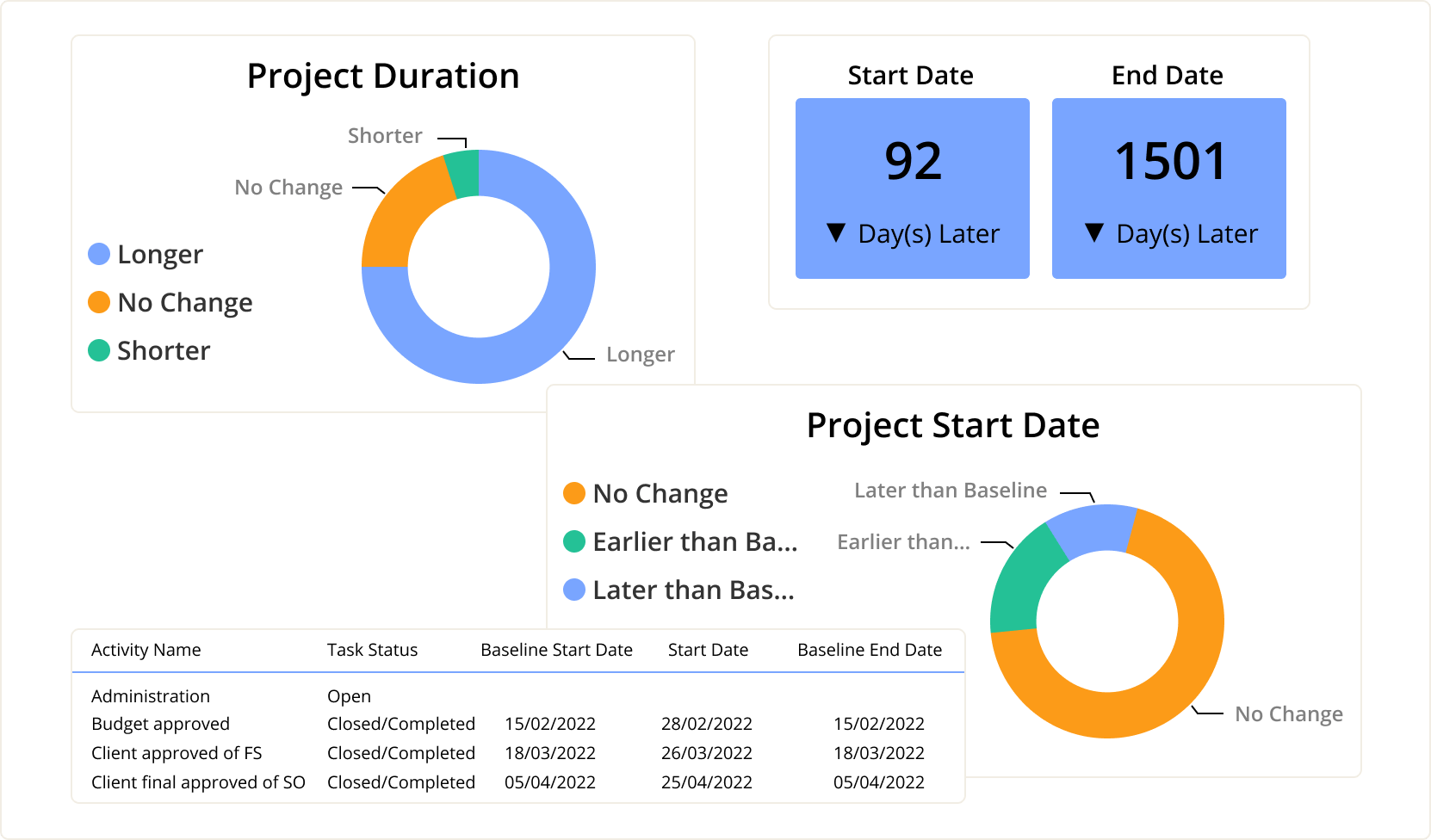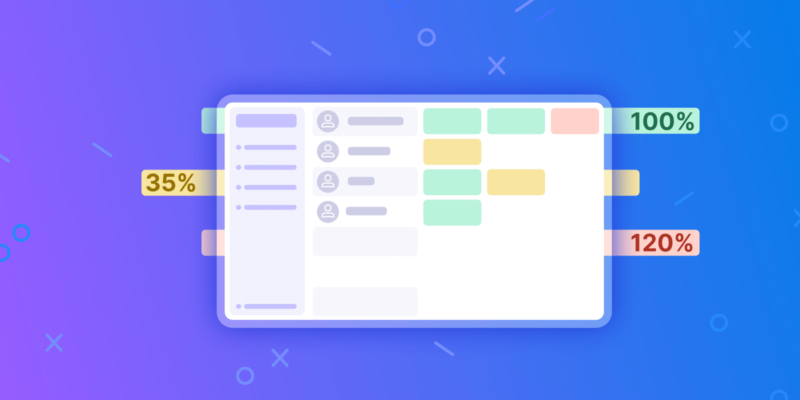An outstanding project proposal is incredibly powerful. A top-notch proposal can grab the attention of key decision-makers and win them over in a matter of minutes.
But how do you craft the perfect project proposal? And what makes a project proposal outstanding? Knowing where to start and what elements to include is critical to your success. Below are the answers to these questions along with the secret to mastering the art of proposal writing.
What is a project proposal?
The project proposal is your pitch, explaining not only what you plan to do but also articulating how and why. A project proposal outlines your project’s core idea and implementation plan, aiming to convince stakeholders of its viability and necessity.
It‘s the blueprint that shows your roadmap from conception through completion, highlighting the benefits all along the way. The effectiveness of your project proposal can determine whether your project receives the green light and the funding it needs.
6 types of project proposal
Understanding the different types of project proposals is crucial to tailoring your document to meet the specific requirements and expectations of your audience. Whether you’re seeking initial funding, aiming to extend a project, or needing to adjust the scope due to unforeseen challenges, selecting the right type of proposal is key to effectively communicating your needs and aligning with your stakeholders’ expectations.
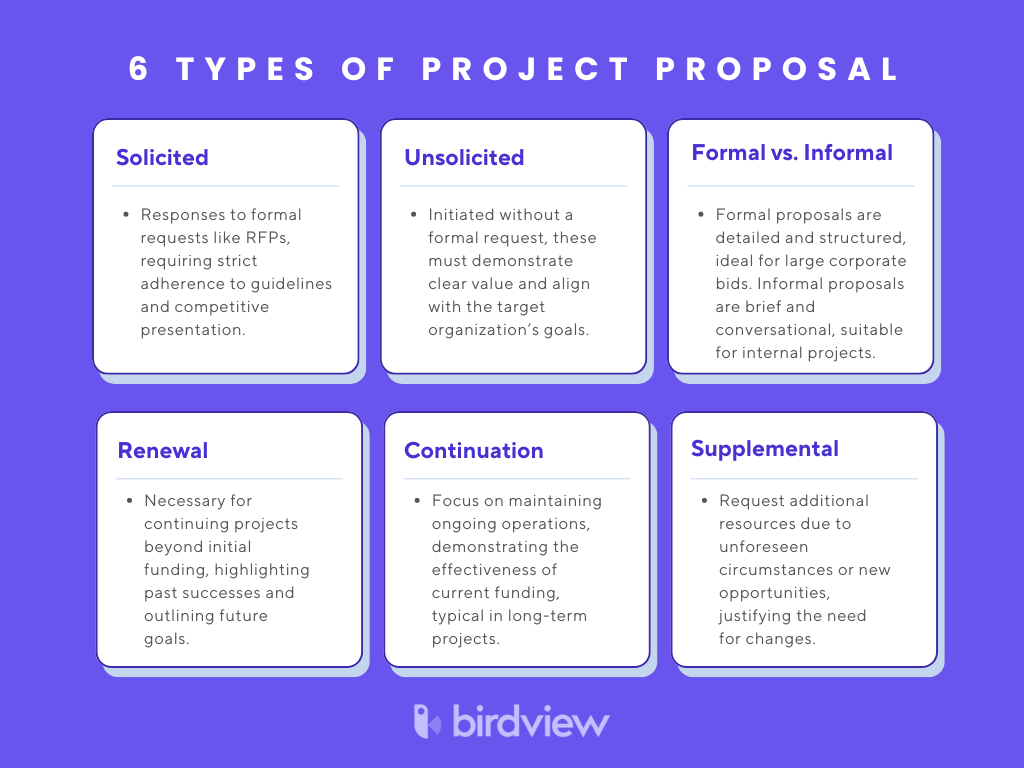
Solicited proposals
These proposals are a response to a formal request by an organization, typically through a Request for Proposal (RFP), Request for Information (RFI), or Request for Quotation (RFQ). These documents provide clear guidelines about the scope of work, submission guidelines, and evaluation criteria. Solicited proposals are competitive and require strict adherence to provided guidelines to be considered seriously. They are common in business-to-business, government contracting, and large-scale organizational contexts.
Unsolicited proposals
These are initiated by someone who identifies a potential need or opportunity and proposes a solution to an organization that has not issued a formal request. Since these proposals are not requested, they must be exceptionally compelling and clearly demonstrate their potential value. The key challenges include identifying a genuine need, aligning the proposal with the prospective sponsor‘s strategic goals, and presenting innovative solutions that capture attention.
Formal vs. informal proposals
The tone and structure of your proposal can vary significantly depending on your relationship with the audience and the context:
- Formal proposals are detailed and structured, suitable for official project bids, especially in sectors like government and large corporations. They require comprehensive details about project plans, budgets, and legal terms.
- Informal proposals may be more brief and conversational, ideal for internal company projects or less formal business ventures. These proposals focus more on the core idea and less on exhaustive specifics.
Renewal project proposals
If your project reaches the end of its initial funding period but still has more to achieve, a renewal proposal is necessary. This type of proposal requires you to demonstrate past successes and justify the need for continued support. It should detail the achievements of the previous phase and outline the objectives for the subsequent phase, emphasizing the potential for continued success and growth.
Continuation project proposals
These are used when you need to maintain the current operations of a project without significant changes. Continuation proposals are routine and expected, primarily focusing on proving the effectiveness of ongoing funding. They are crucial for projects that have consistent and prolonged impacts, often seen in governmental and non-profit sectors.
Supplemental project proposals
Supplemental proposals are appropriate when your project encounters unforeseen circumstances or when new opportunities for expansion arise. These proposals request additional resources or modifications to the existing plan and must justify why these changes are necessary to achieve the desired outcomes or to address new challenges.
What are the qualities of a stellar project proposal?
Before diving into the steps of proposal writing, it is helpful to understand what makes a project proposal truly great. In a nutshell, your proposal should be succinct, easy to follow, and captivating. Here are the four qualities of a stellar project proposal:
- Clear: A great proposal is structured, well-organized, and written with language that is clear and understandable.
- Captivating: An outstanding project proposal grabs the audience’s attention right away, making them want to learn more about your solution.
- Concise: Length does not correlate with success when writing proposals. Your audience members are busy, so be as succinct as possible.
- Convincing: A winning project proposal convinces decision-makers that the project will deliver value and help them achieve their business goals.
Download our free project proposal template to speed up your project management process.
What steps should you follow when preparing your project proposal?
No two project proposals should look exactly alike. They should each reflect the unique needs of the organization they are designed to help. But while the details, timelines, and costs will differ, most proposals include a core collection of points. The process of organizing these points is outlined below in seven simple steps.
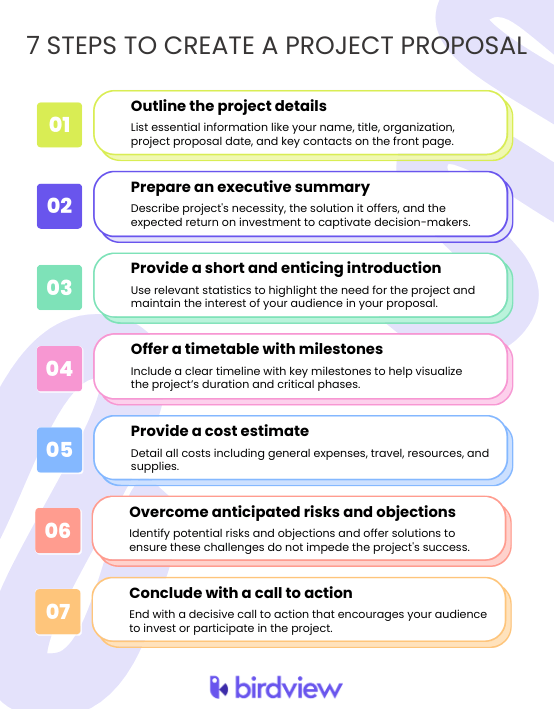
Step One: Outline the project details
The first step is a simple list of the basic details of your project. This identifying information is often listed on the front page of the project proposal. Key pieces of information to reference include the following:
- Your name
- Your title
- The name of your organization
- The name of the organization for which the proposal is prepared
- Project proposal date
- Key project contacts
Step Two: Prepare an executive summary
“Oftentimes, executive summaries are the only place decision makers will go to determine if action is warranted on a particular action or idea. Remember, the people who are reading the summary often do not have much time, so your executive summary must grab their attention and entice them to read through the larger, more in-depth documentation.” – Rasmussen College Library and Learning Services
Your executive summary is more than just a succinct overview of your project proposal. It is the first thing your audience may see. And in some cases, it may be the only part of your proposal your audience sees. Today’s decision-makers are busier than ever, and some may only look at your executive summary. So make sure you prepare a short, but enticing summary that achieves the following:
- Outline the problem or reason your project is needed
- Provides the course of action that will solve the problem (your project)
- Highlights the return on investment the project will produce
Step Three: Provide a short and enticing introduction
Aside from your executive summary, your introduction is the second most important section of your proposal. (Hopefully!) most of your audience is ready to learn more about your project and the purpose of your introduction is to keep them interested in your project.
One of the best ways to do this is to lead with an eye-opening statistic that is relevant to the reader. For example, if you are proposing a new and more efficient CRM, you may start by stating the total number of work hours lost due to technical problems with the existing CRM. Then, translate these hours lost into dollars lost to keep the audience interested in your proposed solution.
Step Four: Offer a timetable with milestones
Your audience will want to know how long it will take to execute your project. It’s critical to include a proposed timeline that features some key project milestones and when they may occur. This helps your audience visualize how the project will unfold and when they will begin to see results.
Use a visual timeline or Gantt chart to illustrate this part clearly and highlight critical milestones and link them to specific project goals. This visual component helps stakeholders quickly understand the project‘s timeframe and major benchmarks.
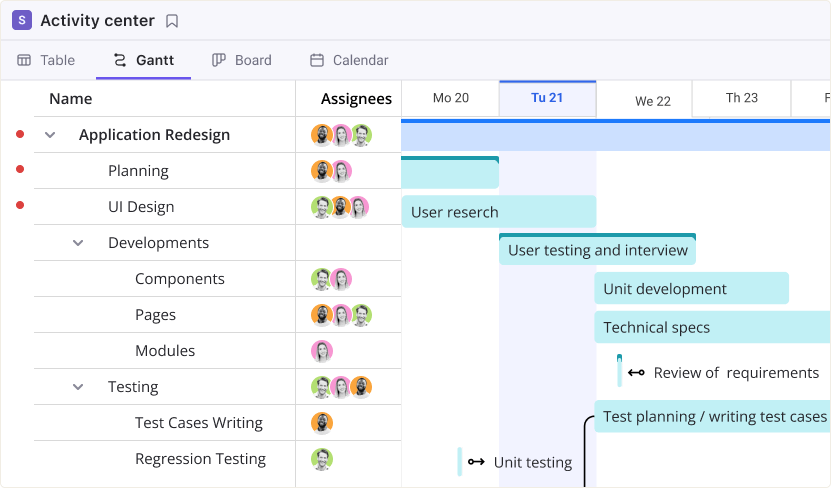
Step Five: Provide a cost estimate
A detailed cost summary is an essential part of any good project proposal. Trying to secure buy-in for a project without outlining anticipated costs is a surefire way for your proposal to be cast aside by executives and stakeholders. Here are some common areas to cover when outlining costs:
- General billing expenses: Note whether the project can be completed for a flat fee or if fees will be based on the time and materials invested.
- Travel expenses: Provide estimated costs for fuel, car rental, hotel accommodations, airfare, entertainment, and meals.
- Project supplies: If your project requires dedicated supplies, make sure to list them and provide approximate costs.
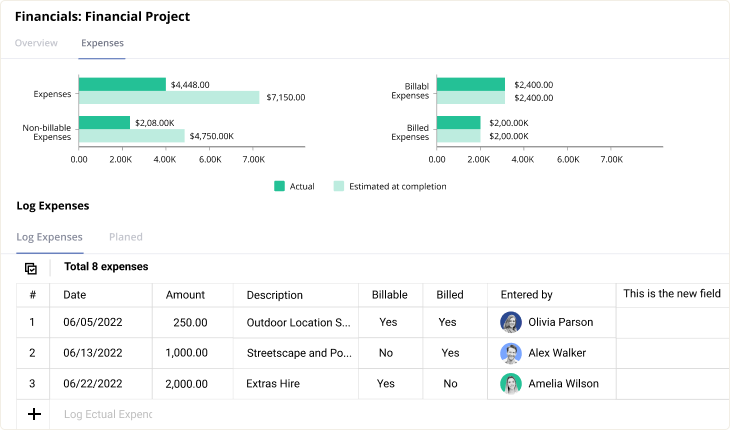
Step Six: Overcome anticipated risks and objections
There are risks associated with virtually any type of professional service project. It’s up to you as the project manager to anticipate these risks, as well as any potential objections. Then provide points in your proposal to make sure they do not derail your efforts.
Step Seven: Conclude with an impactful to action
A well-crafted project proposal deserves a strong finish to leave a lasting impression. Conclude with a concise yet impactful conclusion that highlights the value of your initiative and its alignment with the audience‘s goals. To automate this process, business professionals often go for conclusion maker that creates a polished yet professional ending tailored to the proposal.
What is the secret to writing a bulletproof project proposal: best practices
Creating a great project proposal requires time and effort. But once you create a good template for your proposals, you can re-use it over and over again. You will soon find that you can crank out proposals in a fraction of the time it took you to prepare your first one. You can choose to manually paste data into your template or automate the process by pulling data from your CRM and project management system.
Here are some of the best practices to help you write an outstanding project proposal:
- Leverage technology
Finding the right project management software that can create project proposals by automatically inserting costs and project details into a template is the secret to success. With a great software platform, such as Birdview, you can boost your efficiency, devote more time to higher-value activities, and maximize your productivity.
- Understand your audience
Tailor your proposal to your client or stakeholder’s specific needs and preferences. Understanding their goals, pain points, and decision-making criteria is critical to crafting a proposal that resonates with them.
- Be clear and concise
Avoid jargon and overly complex language. Your proposal should be easy to read and straightforward, with clear headings, bullet points, and concise explanations. Each section should clearly convey its message without overwhelming the reader. To ensure clarity, you can get assistance from an online paraphrase tool. Such a tool can improve the readability of your proposal by eliminating vagueness and improving overall structure of sentences.
- Detail the scope and deliverables
Clearly define what your project will cover and what it will not. List specific deliverables and the benefits they provide to the client. This transparency helps set realistic expectations and reduces the potential for misunderstandings.
- Highlight your unique value proposition
Clearly articulate why your organization is uniquely suited to execute this project. Include case studies, testimonials, or relevant past success stories to build credibility and trust.
- Include a detailed timeline and budget
Provide a detailed and realistic timeline alongside a transparent budget that includes all project costs. Justify your pricing by linking costs to specific project outcomes and deliverables.
- Implement a risk management plan
Identify potential risks and provide proactive strategies for mitigating them. Demonstrating foresight in risk management can reassure clients that the project is well-thought-out and robust.
- Review and revise
Before submission, thoroughly review your proposal for any errors or unclear sections. It can be beneficial to have someone else review it as well to catch issues you might have missed.
- Follow-up
After submitting your proposal, follow up with the client to address any questions or concerns. This not only shows your commitment but also provides an opportunity to clarify any points and adjust the proposal if necessary.
6 project proposal examples by industry
Let’s take a look at project proposal examples across various industries. Each example focuses on clear deliverables, timelines, and outcomes, demonstrating how a well-structured proposal can effectively communicate the value and feasibility of a project.
Project proposal example for engineering
In engineering services, project proposals are typically technical and detail-oriented, focusing on specific engineering solutions. Common types include design proposals, feasibility studies, and project execution plans, all aimed at demonstrating technical viability and cost-effectiveness.
Project title: Automated Assembly Line Installation
Executive summary: This proposal outlines the plan to design and install a customized automated assembly line for a manufacturing company. Our goal is to increase production capacity by 40% and reduce labor costs by 20%.
Problem statement: The manufacturing company’s current production capabilities do not allow it to meet rising market demand, leading to lost revenue and customer dissatisfaction.
Proposed solution: Design a bespoke automated assembly system using state-of-the-art robotics and real-time monitoring software to enhance production efficiency.
Budget: $500,000, including design, machinery, installation, and staff training.
Timeline: 12 months from project approval to go live.
Outcome: Increased production capacity and efficiency, leading to higher customer satisfaction and profitability.
Project proposal example for IT services
IT service proposals often revolve around system upgrades, software implementations, and cloud migration services. Proposals in this sector need to emphasize technical specifications, integration details, and improvements in system efficiency and security.
Project title: Cloud Migration Services
Executive summary: This proposal describes the transition of a company‘s on-premise data center to a fully managed cloud environment aimed at improving scalability and reducing IT overhead.
Problem statement: The company‘s existing on-premise IT infrastructure is costly to maintain and lacks scalability for high-demand periods.
Proposed solution: Migrate the company‘s data center to a cloud platform, providing a scalable, secure, and cost-effective IT infrastructure.
Budget: $200,000 for migration and first year of operations.
Timeline: 6 months for complete migration and system optimization.
Outcome: Enhanced data security, scalability, and a 30% reduction in annual IT maintenance costs.
Project proposal example for architecture
Proposals in architectural services are typically presented to showcase design visions, building plans, and construction strategies. They often focus on architectural innovation, cost analysis, and compliance with zoning and environmental standards.
Project title: Eco-Friendly Commercial Building Design
Executive summary: This proposal outlines the architectural design for an eco-friendly, energy-efficient commercial building for a client, emphasizing sustainability and low operational costs.
Problem statement: The client needs a sustainable building design that minimizes environmental impact while meeting urban development standards.
Proposed solution: Develop a green building incorporating solar panels, rainwater harvesting systems, and high-efficiency HVAC systems.
Budget: $1.2 million covering all phases from design to permit acquisition.
Timeline: 18 months from initial design to final blueprint approval.
Outcome: A sustainable building that reduces energy costs by 50% and aligns with the client‘s commitment to environmental stewardship.
Project proposal example for business consulting
Business consulting proposals are generally strategic or operational in nature. They might address business process improvements, cost reduction strategies, or organizational change management. The focus is on demonstrating the consultant‘s understanding of the client‘s issues and how they propose to solve them.
Project title: Operational Efficiency Improvement
Executive summary: This proposal aims to enhance operational efficiencies for the client through lean management techniques and advanced analytics, resulting in a 25% reduction in operating costs.
Problem statement: The client struggles with high operating costs and inefficiencies in its supply chain and production processes.
Proposed solution: Implement lean management strategies and integrate data analytics to optimize operations.
Budget: $150,000 for consultancy fees and technology implementation.
Timeline: 9 months to achieve measurable improvements.
Outcome: Streamlined operations, reduced waste, and significant cost savings.
Project proposal example for marketing
Marketing services proposals can range from digital marketing strategies to comprehensive branding and advertising campaigns. These proposals typically outline creative concepts, target demographics, expected outcomes, and metrics for measuring campaign success.
Project title: Digital Marketing Campaign for Retail Expansion
Executive summary: This proposal details a comprehensive digital marketing strategy for the client to support its national expansion plans, aiming to increase brand awareness and sales by 30%.
Problem statement: The client is expanding nationally but lacks sufficient brand recognition in new markets.
Proposed solution: Launch a multi-channel digital marketing campaign, including SEO, social media advertising, and influencer partnerships.
Budget: $250,000 covering campaign setup, execution, and monitoring.
Timeline: 1 year campaign duration.
Outcome: Enhanced online presence and brand recognition in key markets, leading to increased sales and customer engagement.
Project proposal example for professional services
In professional services, which include fields like legal, financial, and consulting services, proposals often focus on expertise and regulatory compliance, risk management, or service enhancements designed to improve client operations and legal standing.
Project title: Legal Compliance Program Development
Executive summary: This proposal offers to develop and implement a comprehensive legal compliance program for an enterprise, ensuring adherence to new federal regulations.
Problem statement: The enterprise requires an updated compliance strategy to meet recent changes in federal employment and environmental laws.
Proposed solution: Develop a tailored legal compliance program, conduct staff training, and establish ongoing monitoring mechanisms.
Budget: $100,000 for program development, training, and first-year compliance auditing.
Timeline: 6 months to fully integrate the compliance program into daily operations.
Outcome: Ensured legal compliance, reduced risk of fines, and improved operational transparency.
Automating project proposal
When you’re looking for a project management solution to help automate your project proposals, it’s essential to choose a tool that caters to your specific needs while simplifying your processes. Here‘s what a good project management solution should offer to ensure an effective proposal automation:
- Data integration capabilities
Your ideal solution should be able to effortlessly pull in data from various parts of your project management workflow. This means automatically integrating timelines, budget allocations, and other key project details directly into your proposals. This not only saves time but also enhances the accuracy of the information you present to stakeholders.
- Robust template features
Look for a tool that allows you to create and manage proposal templates easily. The ability to customize templates that auto-fill with project-specific details can greatly speed up the proposal process, ensuring consistency across documents while still allowing each proposal to be tailored to the client‘s needs.
- Collaborative functionalities
Effective proposal automation tools should enhance teamwork through built-in collaboration features. These might include task assignments, progress tracking, and comment sections that allow team members to communicate directly within the document. This helps keep everyone on the same page and ensures that deadlines are met smoothly.
- Version сontrol and audit trails
A good project management solution will help you manage revisions and keep track of all changes made to a document. This transparency is crucial for maintaining the integrity of the proposal and provides valuable insights into the proposal development process, which can be used for future improvements.
- Efficiency in handling responses
The ability to respond quickly to RFPs (Requests for Proposals) can give you a competitive edge. Thus, your chosen solution should enable you to turn around proposals faster by streamlining how information is collected and integrated.
- Scalability and customization
As your business grows, your project management tool should scale with you. It should support increased proposal volumes without a drop in performance or quality. Customization features that allow you to adapt proposals to different clients and project types without starting from scratch are essential.
- Analytics for continuous improvement
Finally, your tool should offer analytics features that allow you to track and analyze what works well in your proposals. Understanding trends and patterns in what resonates with your clients can help you continuously refine your approach.

